 |
||
|
||
| ||
Tests in game applications and in 3DMark2001 (game tests)3DMark2001, DirectX 8.0General results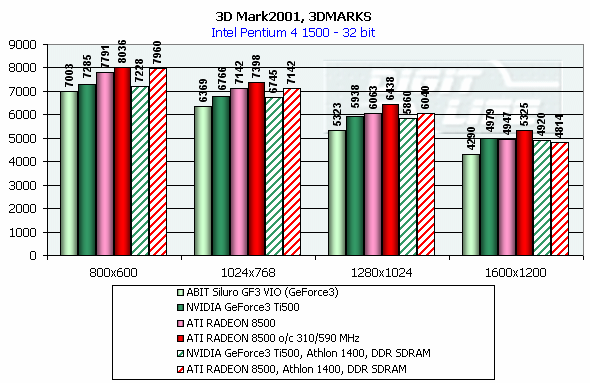 The RADEON 8500 outpaces the NVIDIA GeForce3 Ti 500. Does it mean that in the DirectX games the RADEON will become un unequaled leader? Now let me consider every test included into the 3DMark2001. Here I should note that the performance of both cards hasn't change on a transition from the Pentium4-1500 to the Athlon-1400. Game1, Low details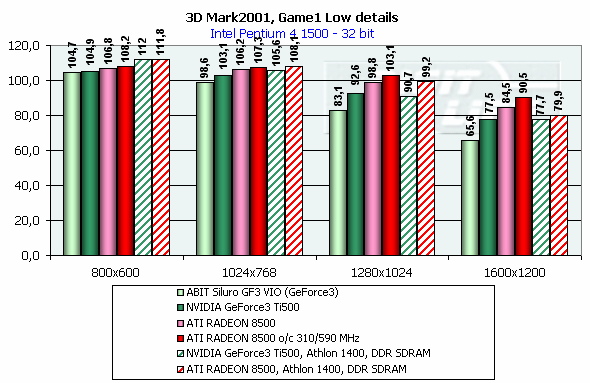 This test combines races and shooters; the scenes are rather complicated, containing lots of effects. The RADEON 8500 nudges out its competitor! Game1, High details The scene from the previous test is even more complex, demonstrates a greater number of effects. Everything here depends on the CPU. Game2, Low details This scene is known not only for complex objects but also for a high Overdraw parameter. It is some kind of one more HSR test (or for HyperZ of the RADEON). Like in the VillageMark, the RADEON 8500 is nicely optimized for such tasks. Neither ZCull or ZCompression can help NVIDIA here. Game2, High details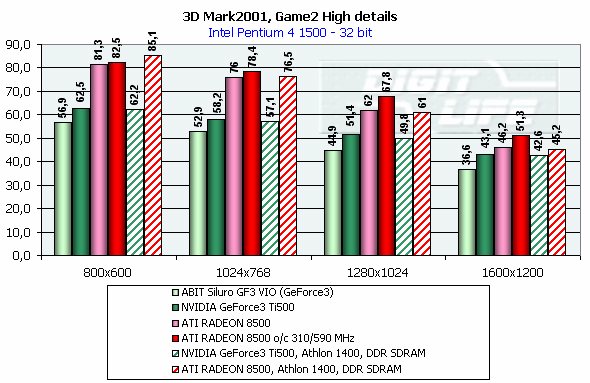 The degree of complexity gets higher: the dragon is now to its full height, other objects look more beautiful as well. The RADEON 8500 still thrives. Game3, Low details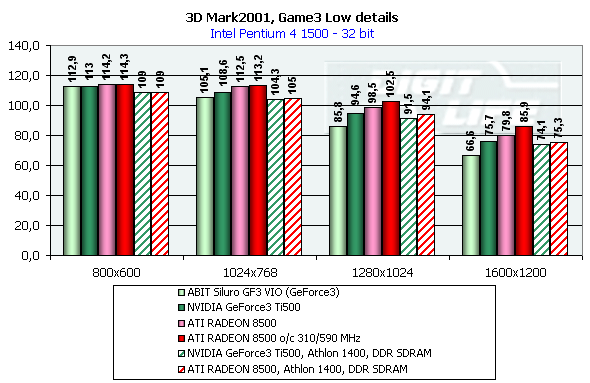 This is a test of another sort. It's like an action test: shootings, flashes, complex objects, a high Overdraw factor etc. The RADEON 8500 keeps the lead so far, though the advantage is not great. Game3, High details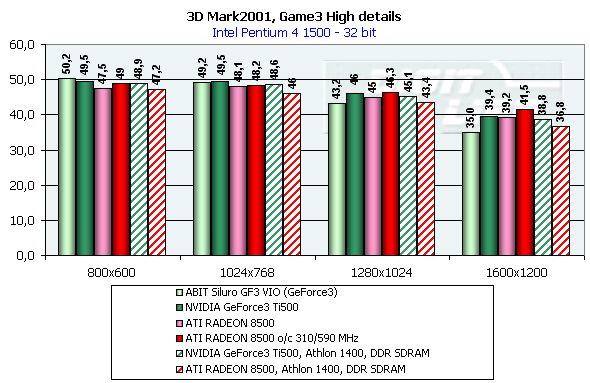 Here is a fly in the ointment! When the number of effects rises the RADEON 8500 loses its superiority, and only in high resolutions it manages to outdo its contenders. Game4 At last, the most beautiful test is available not only for the GeForce3! But the RADEON 8500 lags quite far behind. Do you remember what we talked about the shaders' performance? Well, the fears proved to be true, and this time in a real test scene. In the 3DMark2001 the RADEON 8500 outscored both the GeForce3 and the Ti 500 in all scenes, except the one built with the pixel shaders. Giants, DirectXThe Giants test works under the Direct3D and contains many complex objects (a scene may have over 50,000 polygons).  Why does the RADEON 8500 win in more complicated scenes of the 3DMark2001, and lose here? This game is odd. You might remember that in some versions of the NVIDIA drivers the GeForce3 fell down by 7-10 fps (which is comparable to the today's lost of the RADEON 8500 to the Ti 500), and the following versions improved the situation. I hope the RADEON 8500 will lift its performance at least up to the GeForce3's level with the future versions of the drivers. Quake3 Arena, OpenGLHere we used the v.1.17 of the Quake3 Arena from id Software with a standard demo002 benchmark. Standard test (32-bit color - High Quality mode) It was expected that the Ti 500 would be a leader, but the RADEON 8500 is still able to outscore the earlier model of the GeForce3. The highest detail levelThis test operates not only at the highest possible detail level, but also uses purposely complicated geometry - curved objects are divided into 30,000 polygons (r_subDivisions "1" r_LodCurveError "30000"). 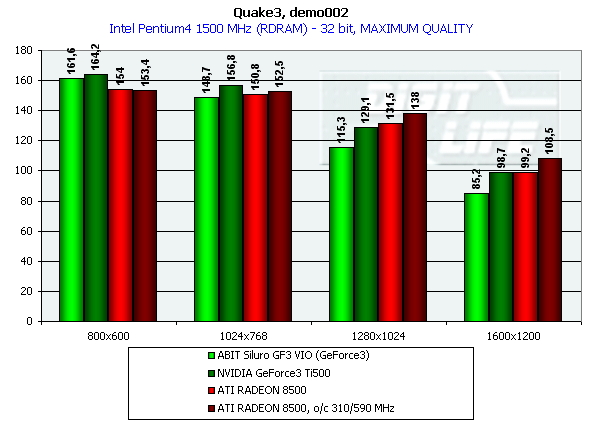 Like before, the RADEON 8500 outpaces its competitors in high resolutions which means that due to the more efficient memory bus and the HyperZ II this test is within its reach, despite the lack for such well debugged and excellent OpenGL drivers as the NVIDIA cards have. By the way, you often recommend me to use newer versions of the Quake3 and even the Quake3 Team Arena as the graphics is much more complicated there. Well, I analyzed that level and drew the conclusion that our heavy test based on the v1.17 gave almost the same load on the card as the demos of the Team Arena. Anisotropic filteringNow comes the most interesting part. You will see that even in the OpenGL sector of games the RADEON has something that can help it win. 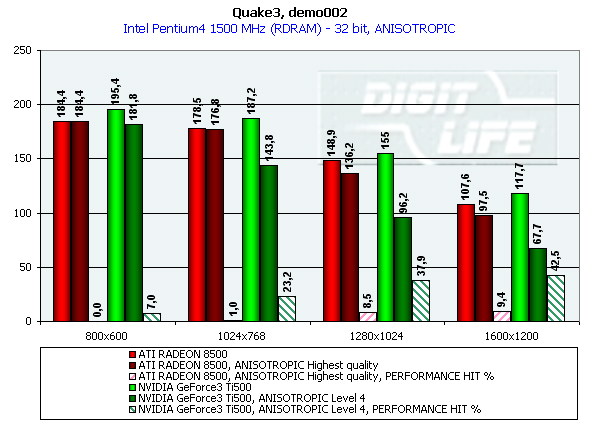 Here I chose the highest anisotropy degree for the RADEON 8500 (available in the drivers) and a middle one (Level4) for the GeForce3 Ti 500. Why? Look how the performance of the Ti 500 drops at even a middle degree of the anisotropic filtering! It is clear that the RADEON 8500 stands a better chance to give a user an excellent graphics at the high speed. But what about quality? Some time ago the RADEON had worse graphics quality at the highest anisotropy degree than the GeForce3. Let's examine the situation in the Serious Sam. Here is the screenshot with the trilinear filtering enabled and anisotropy disabled: 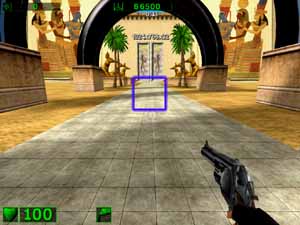 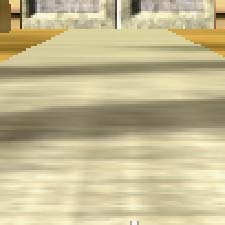 Now let's enable the anisotropy at the Level4 and look at the GeForce3 Ti 500: 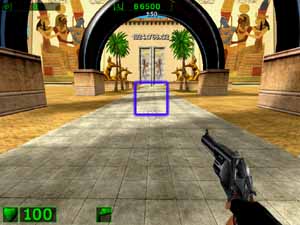 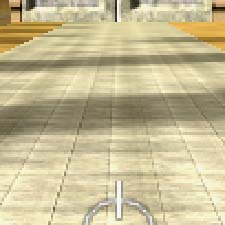 And now we switch the Level8! 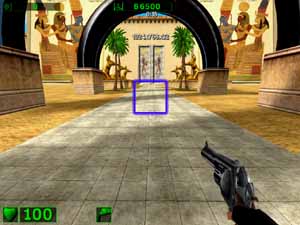 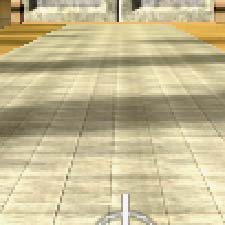 The difference between these two levels is almost unnoticeable. And now comes the RADEON 8500 with its Highest Anisotropic mode: 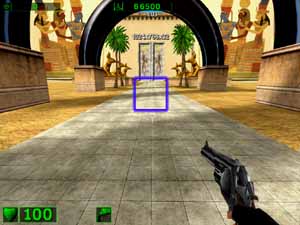 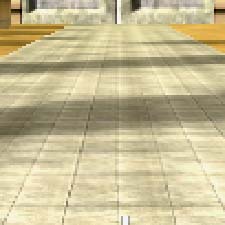 The quality of the anisotropy is at least equal to the GeForce3 Ti 500. And now just look above at the performances drops and make a conclusion. Now the anisotropy is set to the 128-pixel level through the Registry: 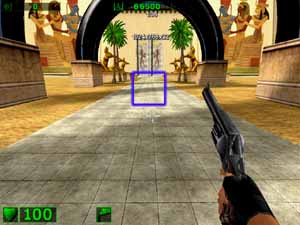 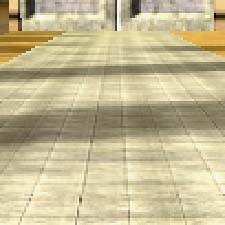 The difference is absent as we expected. In the end I should give the results obtained at the highest possible quality and complicated geometry in the Quake3: 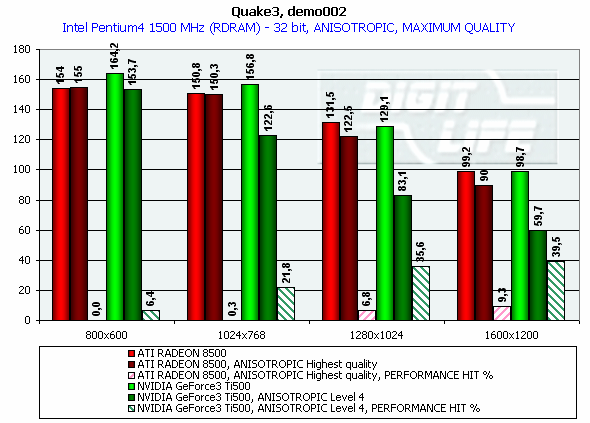 The results are similar to the previous ones. It's a pity we can't enable the anisotropic and trilinear filtering simultaneiously (because of peculiarities of the MIP-mapping of the RADEON). NVIDIA and ATI have quite different methods of realization of anisotropy. In the Part IV we will continue considering this function in the Direct3D as far as graphics quality is concerned. Anti-aliasing and anisotropic filteringTaking into account that the RADEON has a usual super-sampling as the FSAA in the OpenGL, it makes no sense to examine it separately. Unfortunately, the SmoothVision as a type of the AA in the Direct3D doesn't work because of the drivers. That is why let's look at the performance and playability with activation of the AA and anisotropy. 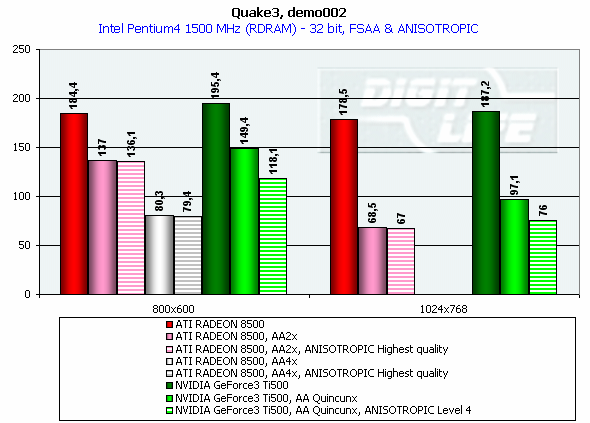 The AA2X and anisotropy provide an excellent playability for the RADEON 8500 in 1024X768X32. The FSAA 4X doesn't operate at this resolution. But the GeForce3 Ti 500, with its AA of higher quality and a good anisotropy level is more efficient. That is why it is obvious that the RADEON loses in the AA+Anisotropy mode. Well, now we are through with the performance issues, and in the Part IV we will study the quality of the graphics. [ Part IV ] Write a comment below. No registration needed!
|
Platform · Video · Multimedia · Mobile · Other || About us & Privacy policy · Twitter · Facebook Copyright © Byrds Research & Publishing, Ltd., 1997–2011. All rights reserved. |